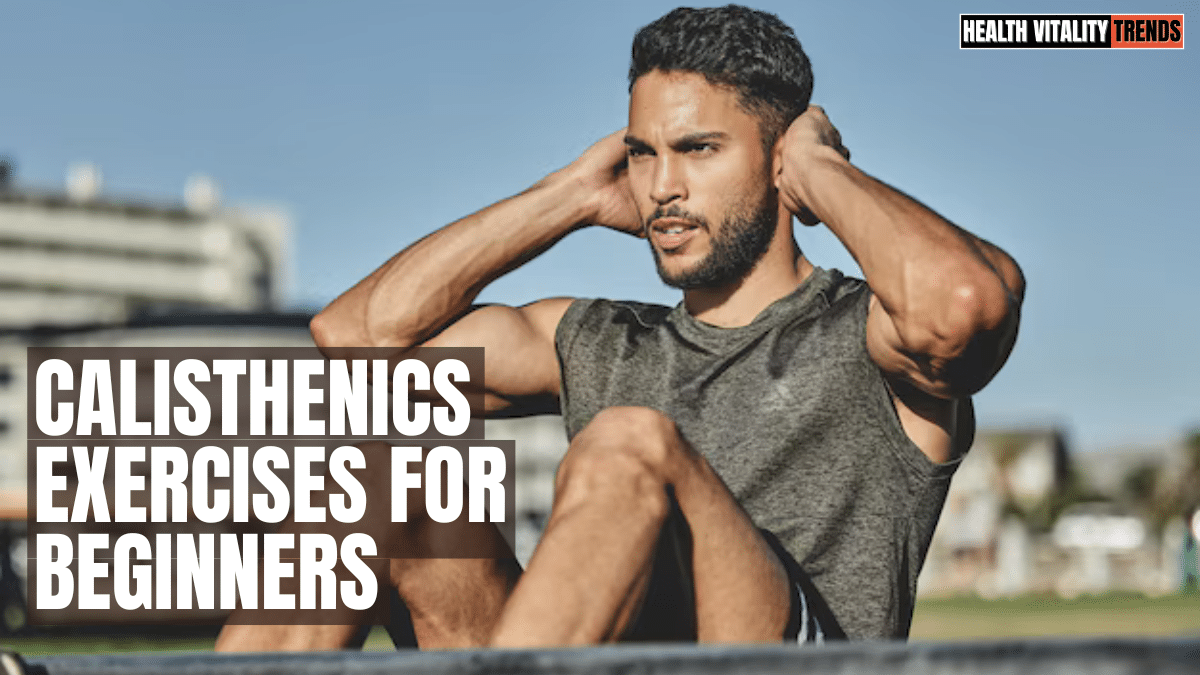
If You Are New to Fitness, Skip The Weights — Do These 10 Calisthenics Exercises That Build Real Strength And Endurance
I get it. If you are here, you are likely new to the world of fitness. And if you are looking for some expert advice on how to start your fitness journey, well, you are in the right place. Let’s begin.
I am very sure that, in this social-media-driven world, you might have come across some young fitness influencers like Sam Sulek, CBum, and Ramon Dino. Or some old-school legends like Ronnie Coleman or Arnold Schwarzenegger in your social media feed. This might have created an urge within yourself to get your first gym membership. Yes, that’s how it starts.
When you first join a gym, it feels like a whole new planet. The entire place is filled with iron plates, cables, dumbbells, machines, and sweat.
And the only thing that comes to your mind is to lift weights as heavy as possible. But this is where many newbies make mistakes, without any prior knowledge about the right way to exercise.
I’m here, as a Certified Personal Trainer, to guide you on how to actually begin your fitness journey. And the best thing is, this method is for all people – regardless of their age or gender.
If you are in a rush and want a quick answer – I advise every beginner that, for the first 2 to 3 months, you do not even need to touch a single dumbbell or barbell. Instead, you should rely more on bodyweight or calisthenics exercises.
The Cold Truth: Why You Shouldn’t Touch Weights (Yet)
What if I told you that the influencers who deeply inspire you are “false influencers”? This is sure very controversial to read, but it’s the cold truth.
So why did I say it?
First of all, you are neither a professional nor an amateur with 5 to 10 years of working out and dieting experience. Understand this: the professionals work out and diet hard because it’s part of their career. You have no such goal.
At this stage[1], your goal should be to become physically strong and agile with your own body weight. This can be achieved if you do more calisthenics exercises and endurance-based activities.
Jumping straight into weighted exercises as a beginner without guidance is a shortcut to muscle imbalances, poor form, and a high risk of injury.
Here is the philosophy I want you to acknowledge:
- Build a Foundation, Not Just Muscle: Do more calisthenics exercises like bodyweight squats, push-ups, pull-ups, running, etc., that engage multiple muscles at a time. If you rely more on isolation exercises (single-muscle exercises) from the beginning, you may face muscle imbalance or strength disparities in your limbs.
- Master Your Movement Patterns: Before you even load plates on a barbell for squats, first learn how to do a bodyweight squat with perfect form. Before you do your first bench press, first master the push-up technique and learn how to actually target your pectoral muscles. You must first learn what the exercise is for, what muscles it works, and what its functions are.
- Define Your “Why”: Again, be very clear about your goals. Do you want to be a bodybuilder, powerlifter, weightlifter, or just an individual looking to get fit? Everyone should define their goals clearly and act & make their plans accordingly.
This foundational phase consists of two key physical pillars: Strength and Endurance. These 10 calisthenics exercises are especially chosen for those who have no prior experience with workouts.
The 10 Calisthenics Exercises Every Beginner Needs
Here is your blueprint. At this stage, your goal is not to set records, but to master the movement of each exercise. You should focus more on form and being consistent with your exercise routine. And evidently, you will progress as you practice more.
1. Push Ups
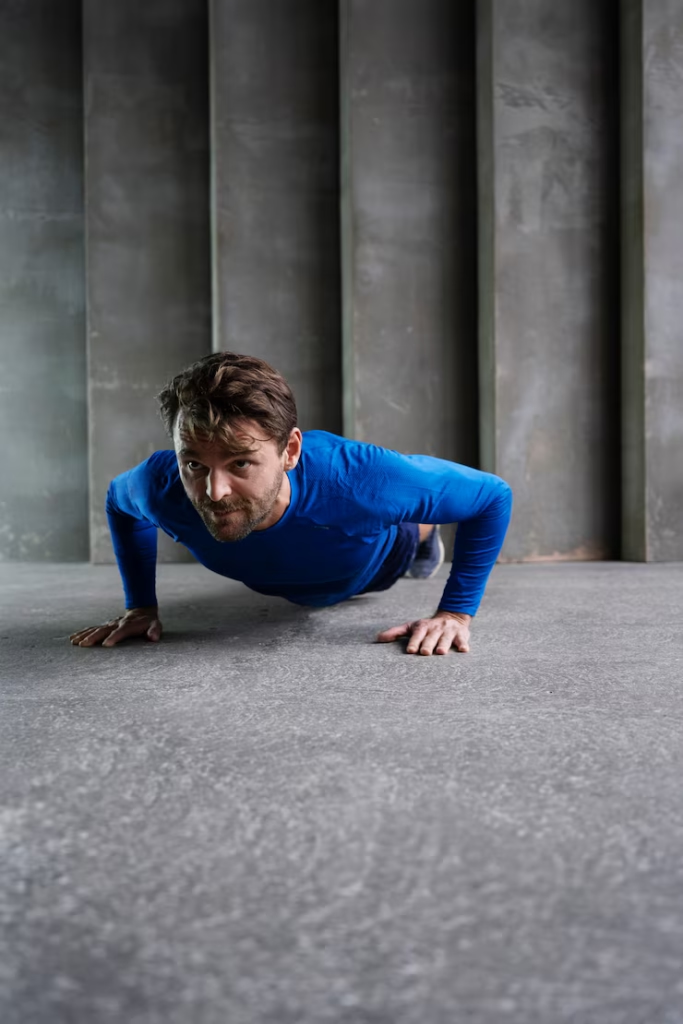
What Does This Exercise Do?
This is the cornerstone of upper-body pushing strength. With Push-ups, you primarily work your chest (pectorals), shoulders (deltoids), and triceps. This exercise also demands significant core stability to maintain the body in a straight line.
How To Do Push-Ups For Beginners:
- On a mat or clean floor, start with the high plank position.
- Keep your arms straight, palms under your shoulder, and tighten your core.
- Now, lower your body until your chest is close to the floor, but not touching it.
- Your elbows should be at a 45-60 degree angle from your body and not flared out.
- Now push upwards with all your strength by focusing on your chest muscles.
Sets and Repetitions: 3 sets of 8-15 repetitions
2. Pull Ups or Chin Ups
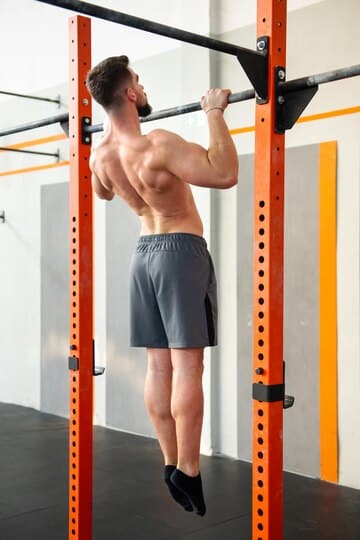
What Does This Exercise Do?
This is the most essential upper-body pulling movement, which helps you with activities such as climbing a wall or climbing with a rope. This exercise builds a powerful back (lats, rhomboids) and biceps that are crucial for having good posture. Pull-up is more back-dominant, while chin-up is more bicep muscle dominant exercise.
How To Do Pull-Ups For Beginners:
- For this, you need a wall-mounted pull-up bar, similar to what you find in a gym.
- Jump slightly and grab the bar.
- Grab the bar with an overhand grip (for pull-up) or with an underhand grip (for chin-up).
- The hand position in a chin-up should be slightly wider than your shoulder length, while for a chin-up, it should be parallel to your shoulder position.
- Whenever you are ready to lift up, tighten your core and pull yourself up.
- Keep going up until the pull-up bar reaches near your chest.
- Now, slowly lower yourself with controlled movement, and back to the starting position.
Sets & Repetitions: 3-4 sets of 10 to 15 repetitions.
3. Body Weight Squats

What Does This Exercise Do?
Squat is one of the fundamental exercise for the lower body, which targets your quadriceps, glutes, and hamstrings. When you practise bodyweight squats more often, it teaches you the essential hip-hinge technique, which you often use in sitting, getting up after sitting, and countless daily activities.
How To Do Bodyweight Squats For Beginners:
- Again, on a clean yoga mat or floor, stand with your feet that are shoulder-width apart.
- Keep the position of your toes slightly pointing outside.
- Look forward, with chin up and chest up.
- Move your arms in front as seen in the above image.
- Descend until your thighs are at least parallel to the floor.
- Now, to lift yourself up. Focus prominently on your heels (not your toes) and get up and return back to standing position.
Sets & Repitions: 4 sets of 10 to 15 repetitions.
4. Forward and Reverse Lunges

What Does This Exercise Do?
Lunges are the second most effective exercise for your legs. And the best part is this exercise trains your leg unilaterally, developing similar strength and muscular development in the lower limbs. Lunges intensely work on your glutes, hamstrings, and quadriceps muscles, while challenging your core for maintaining balance.
How To Do Lunges For Beginners:
- Forward Lunge: Simply keep both hands on your waist. Now, step forward with one leg, and lower the body until the knees are bent at a 90-degree angle. Your front knee should be above the ankle, and your back knee should not touch the ground. Move forward, and get back to the starting position, and repeat the same with the other leg.
- Reverse Lunge: In this, the starting position is the same as forward lunges, but now you have to step backward instead of forward. This is often easier on the knees.
Sets & Repetitions: 3 sets of 10 – 15 repetitions (you have to do 10 to 15 repetitions with each leg, so overall steps will be 30).
5. Triceps Dips
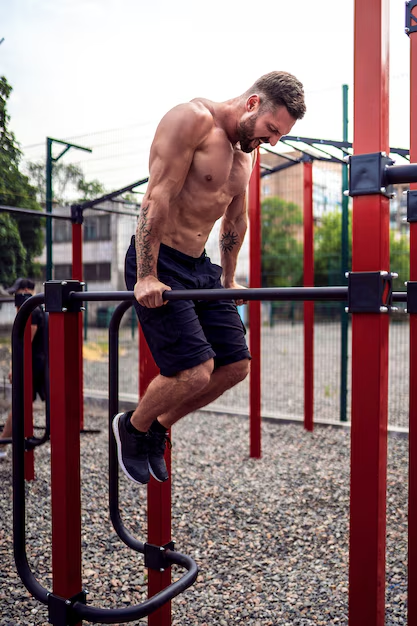
What Does This Exercise Do?
As the name implies, this exercise isolates and builds raw triceps strength, which is more beneficial in daily activities than doing cable triceps extension in the gym. This exercise engages your lower chest and shoulder stabilizers as well.
How To Do Triceps Dips For Beginners:
- To do tricep dips, you will need parallel bars set up.
- Stand between the parallel bars. Both of the bars should be on your sides.
- Make a jump, and immediately grab the bar with your hands.
- Do not swing your body, and hold this position.
- Using your elbows as the point of action, lower your body slowly.
- Bend your elbows until it is parallel to the ground, making a 90-degree angle.
- Now, push down through your palms to straighten your arms.
Sets & Repetitions: 4 sets of 10 to 12 repetitions.
6. Inverted Rows

What Does This Exercise Do?
If you are familiar with the rowing exercises, such as Barbell rows or machine rows, the inverted row exercise follows the same pulling movement for the rhomboid muscles. Having strong rhomboid muscles directly helps combat a hunched-forward posture caused by a sedentary lifestyle.
How To Do Inverted Rows For Beginners:
- To do an inverted row, you will need a Smith machine or a squat rack.
- Set a barbell in a squat rack to your waist height or use a TRX/suspension trainer.
- Carefully lie underneath the bar, grab the bar with an overhand grip, and walk your feet forward so your body is at an angle.
- Keep your body rigid and pull your chest up to the bar, squeezing your shoulder blades together to target the rhomboid muscles.
Sets and Repetitions: 4 sets of 10 to 15 repetitions
7. Sit Ups and Leg Raises
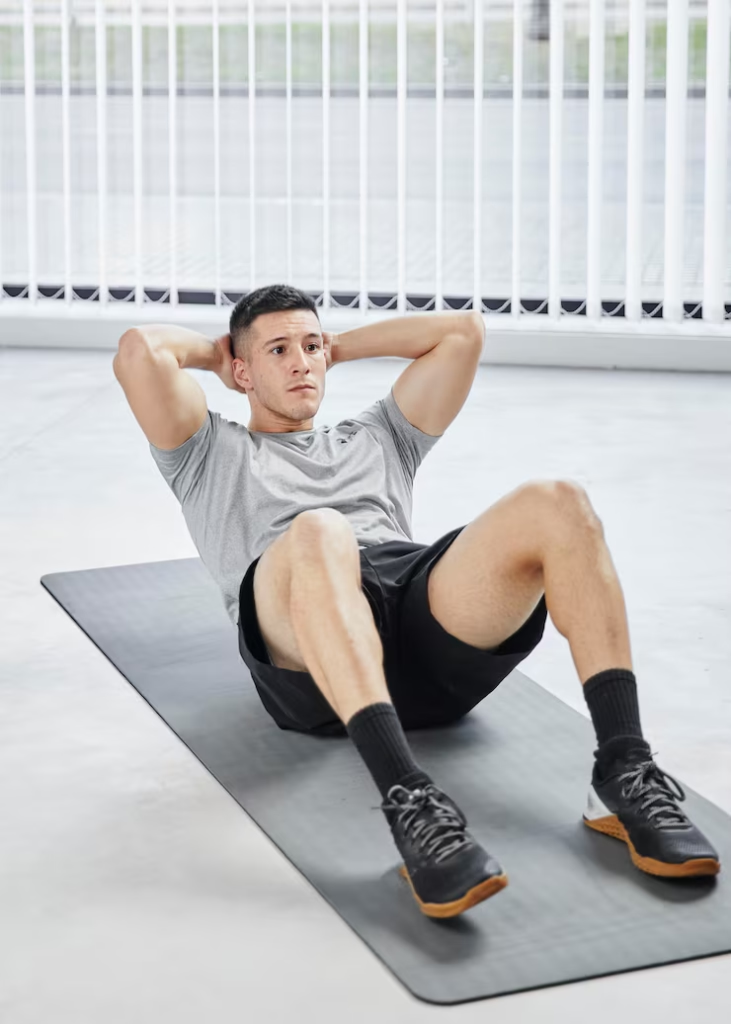
What Does This Exercise Do?
The combination of sit-ups and Leg raises works on your core from two angles. Sit-ups target the upper and central abdominals, while the lying leg raises focus on the lower abdominals and hip flexors.
How To Do These Exercises For Beginners:
- Sit-ups: Place a clean yoga mat on the floor. Now, lie on your back, bend your knees, and keep your hands close to your head. Engage your core to lift your torso, stop when your chest reaches the knee, then lower with controlled motion.
- Leg Raises: Lie on your back, and place your hands near your hips. To begin with, always keep your legs straight and now raise them until they are vertical to the floor. Lower them slowly without touching them to the ground.
Sets & Repetitions: You have to do Sit-ups and Leg raises consecutively at a time. 4 sets or 15 repetitions for both.
8. Planks

What Does This Exercise Do?
Planks are considered the ultimate core stability exercise. Most of us confuse planks for building abdominal muscles, but in reality, it is an isometric exercise, which means there is tension in the muscle, but without changing the length of that muscle.
How To Do Planks For Beginners:
- If you are in a gym or at home, first place a yoga mat on the floor.
- Similar to a push-up position, place your body on the mat.
- Now, place your forearms on the ground with your elbows aligned below your shoulders.
- Your body should form a straight line from your head to your toes.
- To do the exercise, brace your core and glutes, and hold the position without letting your hips sag or rise.
Sets and Repetitions: 4 sets of planks, up to 1 minute. Increase timing if you get comfortable with the previous record.
9. Long Distance Jogging/Running

What Does This Exercise Do?
As explained before, a beginner’s job is to cover all aspects of fitness, and cardiovascular endurance is one of the important components of fitness. Jogging is an aerobic activity that not only strengthens your heart and lungs but also improves blood circulation and builds the mental fortitude for sustained effort.
How To Start Jogging or Running For Beginners:
- If you have never run or jog, don’t worry about the speed at all. You just have to maintain your pace without giving up too fast.
- Start with a brisk walk or mild jogging. For example: 5 minutes of walking, followed by 2 minutes of jogging. For 20-30 minutes.
- Gradually increase the jogging interval as your fitness level improves.
Your DAY 1 will be the most uncomfortable. Your cardiovascular health can only improve if you break your limit each day or week. So set your weekly goals.
10. 100 m Sprinting
What Does This Exercise Do?
Unlike jogging or running, which have to be performed for long distances. Sprinting is an anaerobic activity. Which means you have to cover a 100m track length as soon as possible. So, your natural response to this will be to run as fast as possible and not jog.
How to Practise 100m Sprint for Beginners:
- To practise 100m sprinting, you will need a track & field zone. Or an open zone.
- First of all, you have to warm your body up; for that, you can jog up to 5 minutes.
- Do a warm-up sprint at 70 to 80% capacity of the 100m track. (approx 15 seconds)
- Take rest.
- Now you are ready for the main set. Run!
- Cover the 100m in the minimum time.
- Practice of 4 to 5 sets, if you are comfortable.
Sets and repetitions: 4 to 5 sets of sprinting for practice. If you are completely new, 1 to 2 rounds are enough.
Fueling Your Foundation: A Note on Beginner Nutrition
If you are still here, Congrats – Being consistent is the most important aspect of being a fit individual. And unlike other readers, you are onto the next part of the most important component of fitness, which is your Nutrition.
Understand this – Exercising changes your body. Because now you’re actively burning more calories from the muscles and fat. Therefore, you need the right nutrition that not only helps you recover but also builds lean muscles.
For a beginner, nutrition doesn’t have to be complicated. In fact, you really don’t need to use any types of supplements right now. Focus on the whole and single-ingredient foods, such as: Lean protein, complex carbohydrates, and healthy fats. You must also include plenty of vegetables and water.
The Path Forward
As a CPT, I will advise one thing: Don’t complicate your workouts or nutrition as a newbie.
Keep things simple, and for the next 60 to 90 days, your mission should be very clear: That is, to be consistent with your training. Your first day and first week will be the most difficult to conquer mentally.
Celebrate every extra rep, every extra second on the plank, and every extra kilometer you run.
If you are successful in building this foundation of functional strength and endurance[2], you have become more fit than most of the population on this earth.
References:
[1] https://www.researchgate.net/publication/317321468
[2] https://www.researchgate.net/publication/354284325


